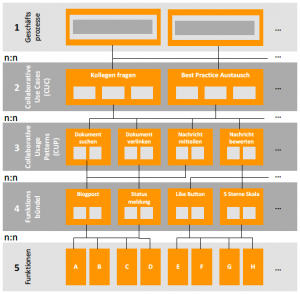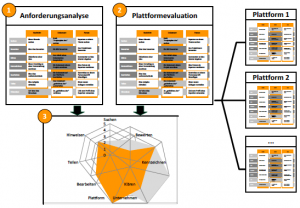Enterprise 2.0 (and Social Business respectively) is still in its enfants. Nevertheless, enterprises of all sizes are facing the challenge to adapt and evaluate Social Business Software (SBS) and platforms.
In this post, I point to “aperto”, a framework of the “Forschungsgruppe Kooperationssysteme” of the “Universität der Bundeswehr München”, which might help companies of any size which want to evaluate and implement Social Business Software (SBS) in their daily workflows.
Key messages between the lines
Some of the key messages between the lines are the following (see [Ri+12]) :
- Social Software is an open platform
- The features do not predispose particular forms of usage
- There are different views on Social Business Software
- Experimentation happens in context
- Usage-orientated documentation will help with the adaption of SBS
The paper follows the before published paper of Riemer and Richter from 2009:
“(…) as SNSs are open and rather flexible technologies, these systems do not lend themselves to immediate forms of usage determined or prescribed by their features. Rather, they need to be appropriated through experimentation and sense making by the users, a process that takes time and is also open-ended in the sense that its outcome is open (…)”
[RiRi09, p. 8]
Within the aperto framework, among others, there are two useful elements, the 5-level-model and the evaluation procedure.
5-level-model
aperto covers a 5-level-model, in which Business Processes, Collaborative Uses Cases (CUC), Collabrative Usage Patterns (CUP), Functional Bundles and Functions are differentiated. The Collaborative Usage Patterns (CUPs) act as a useful bridge between CUCs and Funcional Bundles and close the missing link between Uses Cases and Functions.
Use Cases
In addition, a catalog of CUCs is provided, which can help enterprises to find their suitable use cases to reach company-specific goals.
As mentioned before, the approach provided by the university is a useful model to find the right platform in pursuit of enterprise-specific goals.
Evaluation
The evaluation consists of following steps:
- Functional requirements analysis
- Platform evaluation
- Comparison of requirements profile with platform profiles based on Collaborative Use Cases (CUCs)
The usage of webspiders and platform profiles allows to avoid an extensive and unnecessary analysis of Social Business Software Suites like Jive, SharePoint, Confluence or Lotus Connections.
Change
It goes without saying that the adoption of a SBS is accompanied by a change process. To make change possible, the authors suggest a usage-orientated documentation. Usage-orientated examples in the documentation help users to settle in the new platform.
Pragmatic way
As some enterprises already successfully make use of this new model and the pragmatic way of the authors is more than an academic study, I am looking forward to hearing from the authors again in describing more examples of practical application…
Some words from the authors, “Kurzfassung” (German language)
“Der Einsatz von Social Software zur Unterstützung der Zusammenarbeit in und zwischen Unternehmen gewinnt seit mehreren Jahren zunehmend an Bedeutung. Gleichzeitig machen die Charakteristika von Social Software – allen voran deren sogenannte Nutzungsoffenheit – ein Umdenken notwendig. Corporate Social Software unterscheidet sich eklatant von traditionellen betrieblichen Anwendungssystemen, denen bereits bei ihrer Entwicklung klare Strukturen und vorher vorgegebene bzw. definierte Nutzungsszenarien zugrunde liegen. Klassische Vorgehensweisen der Anforderungsanalyse betrieblicher Anwendungssoftware, des IT-Change Management und der IT-Evaluation können hier nur noch bedingt oder gar nicht weiterhelfen. Im vorliegenden Beitrag wird das aperto-Rahmenwerk, bestehend aus dem aperto-Fünf-Ebenen-Modell, der CUP-Matrix sowie den daraus entwickelten Werkzeugen vorgestellt. Es ermöglicht die vollständige und konsistente Kategorisierung und Klassifizierung der Nutzungspotentiale von Corporate Social Software und unterstützt somit deren Auswahl, Einführung und Optimierung. Das im Beitrag beschriebene Vorgehen kam in den letzten Monaten mehrfach erfolgreich in Auswahl- und Einführungsprojekten deutscher Unternehmen zum Einsatz.”
[Ri+12, p. i]
The framework is published under the “Creative Commons Attribution Non Commercial NoDerives Lizenz”, see http://creativecommons.org/licenses/by-nc-nd/3.0/de/
References list:
- [Ri+12] Richter, Alexander; Koch, Michael; Behrendt, Sebastian; et al.: “aperto – Ein Rahmenwerk zur Auswahl, Einführung und Optimierung von Corporate Social Software” in “Schriften zur soziotechnischen Integration”, Band 2. URL: http://a.soziotech.org/GXNQ3e – last verified on May 20, 2012;
München: Forschungsgruppe Kooperationssysteme, Universität der Bundeswehr München, 2012 - [RiRi09] Richter, Alexander; Riemer, Kai: “Corporate Social Networking Sites – Modes of Use and Appropriation through Co-Evolution” in “20th Australasian Conference on Information Systems”. URL: http://www.kooperationssysteme.de/docs/pubs/RichterRiemer2009_ACIS2009_SNS.pdf – last verified on May 20, 2012;
München / Sydney: Australasian Conference on Information Systems (ACIS), 2009

